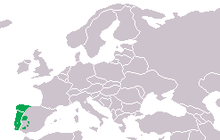Spanish newt
| Spanish newt | ||||||||||||
|---|---|---|---|---|---|---|---|---|---|---|---|---|

Spanish newt ( Lissotriton boscai ), male |
||||||||||||
| Systematics | ||||||||||||
|
||||||||||||
| Scientific name | ||||||||||||
| Lissotriton boscai | ||||||||||||
| ( Lataste , 1879) |
The Spanish newt ( Lissotriton boscai , Syn. : Triturus boscai , cf .: Triturus ) is a southwestern European Salamander -Art. The specific epithet honors the Spanish zoologist Eduardo Boscá (1843–1924).
description
The up to 75 mm long males do not form a back crest during the mating season. However, both sexes then have a low, smooth-edged fin edge, as well as a tail thorn. The females get a little larger with up to 94 mm. The back is very flattened; The males in particular have an almost square cross-section due to the raised back gland ridges. A longitudinal furrow runs in the middle of the head; Another characteristic is the clearly developed ear glands (parotids).
The color is yellow to olive brown on the upper side with dark spots that are coarser in the male than in the female. The belly and throat are orange-red to yellowish and darkly spotted. In the transition to the flanks there is a whitish stripe, which is often bordered by larger round spots. In the national costume the skin is velvety and water-repellent; A reddish line is then noticeable on the middle of the back and the parotids are yellowish to reddish.
Occurrence, way of life
The Spanish newt colonizes the western part of the Iberian Peninsula , namely all of Portugal and the north-west and west of Spain. It lives in the hills and mountains up to an altitude of over 1900 meters. Heath, forests and cultivated land serve as land habitats during the summer months. During this time the animals are nocturnal. Some spend all year in the water; the others appear in the spawning waters from the end of November - smaller ponds, fountain basins and streams with clear, cool water, and sometimes even cave waters. The breeding season sometimes lasts until July. The male performs a complicated, species-specific courtship dance, during which the female is indirectly given a spermatophore for internal fertilization. A female produces 100 to 240 eggs per season. Most of the larvae metamorphose in May and June. However, it is not uncommon for them to overwinter at higher altitudes and do not transform into a newt until the following year.
The most important predators are the larger marble newts , which often occur syntopically . The range of food for the Spanish newts includes various invertebrates; the larvae mainly eat water fleas and aquatic insect larvae.
literature
- Andreas Nöllert, Christel Nöllert: The amphibians of Europe. Kosmos-Franckh, Stuttgart 1992. ISBN 3-440-06340-2
- Heinz Schröder: amphibians and reptiles in colors . Otto Maier Verlag, Ravensburg 1973. ISBN 3-473-46116-4
Web links
- Pictures at herp.it
- Lissotriton boscai in the Red List of Threatened Species of the IUCN 2008. Posted by: Jan Willem Arntzen u. a., 2006. Retrieved April 23, 2009.
